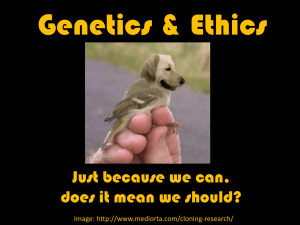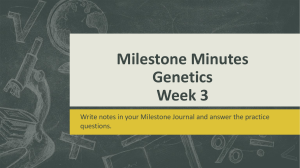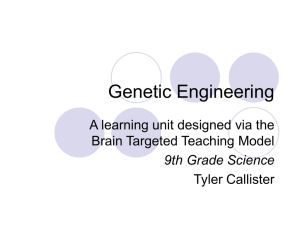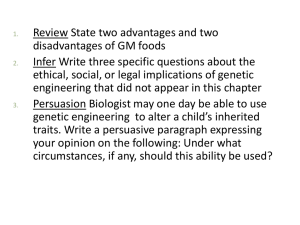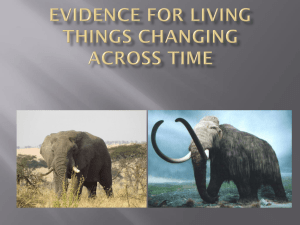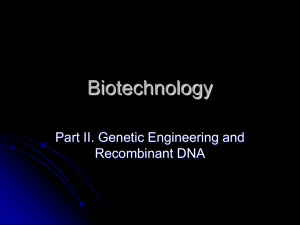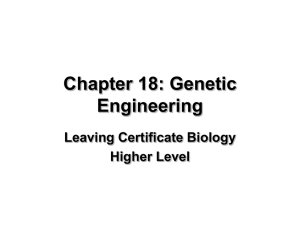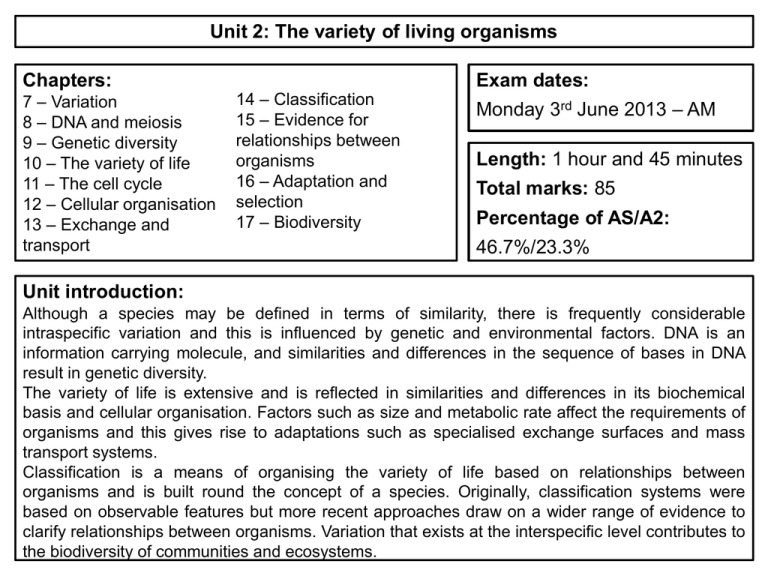
Unit 2: The variety of living organisms
Chapters:
7 – Variation
8 – DNA and meiosis
9 – Genetic diversity
10 – The variety of life
11 – The cell cycle
12 – Cellular organisation
13 – Exchange and
transport
14 – Classification
15 – Evidence for
relationships between
organisms
16 – Adaptation and
selection
17 – Biodiversity
Exam dates:
Monday 3rd June 2013 – AM
Length: 1 hour and 45 minutes
Total marks: 85
Percentage of AS/A2:
46.7%/23.3%
Unit introduction:
Although a species may be defined in terms of similarity, there is frequently considerable
intraspecific variation and this is influenced by genetic and environmental factors. DNA is an
information carrying molecule, and similarities and differences in the sequence of bases in DNA
result in genetic diversity.
The variety of life is extensive and is reflected in similarities and differences in its biochemical
basis and cellular organisation. Factors such as size and metabolic rate affect the requirements of
organisms and this gives rise to adaptations such as specialised exchange surfaces and mass
transport systems.
Classification is a means of organising the variety of life based on relationships between
organisms and is built round the concept of a species. Originally, classification systems were
based on observable features but more recent approaches draw on a wider range of evidence to
clarify relationships between organisms. Variation that exists at the interspecific level contributes to
the biodiversity of communities and ecosystems.
Unit 2: Chapter 7: Variation
7.1 Investigating variation:
Key words:
How is variation measured?
What is sampling and why is it used?
What are the causes of variation?
interspecific variation; intraspecific variation: sampling
bias; chance; random sampling; sample size; mutations;
meiosis; fusion; gametes; genetic; environmental
What is interspecific variation?
How can a population be sampled?
What is intraspecific variation?
Why might samples not be representative of a
population?
What is meant by the term genetic
variation?
How can we increase the reliability of a
sample?
What is meant by the term environmental
variation?
Unit 2: Chapter 7: Variation
7.2 Types of variation:
Key words:
What are the types of variation?
What is the mean of a normal distribution?
What is standard deviation and how is it calculated?
normal distribution curve; mean;
standard deviation;
What is genetic variation? Cont.
Label the graph of
normal distribution
What is environmental variation? Cont.
The equation for standard deviation is:
𝑠𝑡𝑎𝑛𝑑𝑎𝑟𝑑 𝑑𝑒𝑣𝑖𝑎𝑡𝑖𝑜𝑛 =
(𝑥 − 𝑥)2
𝑛
Where:
∑ = the sum of
𝑥 = measured value (from the sample)
𝑥 = mean value
𝑛 = the total number of values in the sample
Practice the using the equation with the values
0, 1, 2, 3, 4 and 5:
Unit 2: Chapter 7: Variation
Exam questions
Explain what is meant by genetic diversity.
(1 mark)
Apart from genetic factors what other type of factor causes variation within a species?
(1 mark)
The spotted owl is a bird. Numbers of spotted owls have decreased over the past 50 years.
Explain how this decrease may affect genetic diversity.
(2 marks)
Unit 2: Chapter 7: Variation
Exam questions
The crimson topaz and the fiery topaz are
hummingbirds.
Biologists investigated whether the crimson topaz and
the fiery topaz are different species of hummingbird, or
different forms of the same species.
Explain how the standard deviation
helps in the interpretation of these
data.
They caught large numbers of each type of
hummingbird. For each bird they
•
recorded its sex
•
recorded its mass
•
recorded the colour of its throat feathers
•
took a sample of a blood protein.
The table shows some of their results.
(2 marks)
Unit 2: Chapter 8: DNA and meiosis
8.1 Structure of DNA:
Key words: cytosine; thymine; adenine;
What are the component of DNA?
How are these components arranged within the DNA
double helix?
What is the function of DNA?
guanine; phosphate; deoxyribose sugar;
condensation reaction; mononucleotide;
dinucleotide; polynucleotide; complementary;
double helix;
Label the diagram of DNA to show the
components of DNA and how they are
arranged:
Explain why pairing of bases:
Explain why DNA forms a double helix:
Explain the function of DNA:
Unit 2: Chapter 8: DNA and meiosis
8.2 The triplet code:
Key words:
What is a gene?
How do genes code for polypeptides?
gene; triplicate code; polypeptide;
amino acid
What is a gene?
What the triplicate code?
Unit 2: Chapter 8: DNA and meiosis
8.3 DNA and chromosomes:
Key words: prokaryotic cell;
How does DNA in prokaryotic organisms differ from the DNA in eukaryotic
organisms?
What is a chromosome?
How are genes arranged on a DNA molecule?
What are homologous chromosomes?
What is an allele?
eukaryotic cell; chromosomes;
chromatid; centromere;
histone; homologous pairs;
allele
How does DNA in prokaryotic organisms
differ from the DNA in eukaryotic organisms?
What is a homologous chromosome?
What is an allele?
Fill in the boxes to show how DNA in packed
into a chromosome:
Unit 2: Chapter 8: DNA and meiosis
8.4 Meiosis:
Key words:
Why is meiosis necessary?
What happens during meiosis?
How does meiosis create genetic variation?
mitosis; meiosis; gametes; diploid; haploid;
crossing over; gene; locus; allele;
interdependent segregation; recombination;
What is meiosis? Use the diagram in your
explanation.
Explain interdependent segregation and how this
leads to genetic variety:
Explain genetic recombination by crossing over:
Unit 2: Chapter 8: DNA and meiosis
Exam questions
The diagram shows part of a DNA molecule.
Name the two components of the part of the
DNA molecule labelled M.
1
2
(2 marks)
What is the maximum number of amino acids
for which this piece of DNA could code?
(1 mark)
Scientists calculated the percentage of different
bases in the DNA from a species of bacterium.
They found that 14% of the bases were guanine.
What percentage of the bases in this species of
bacterium was cytosine?
Answer ....................................... (1 mark)
What percentage of the bases in this species of
bacterium was adenine?
Answer ....................................... (1 mark)
The scientists found that, in a second species of
bacterium, 29% of the bases were guanine. Explain
the difference in the percentage of guanine bases
in the two species of bacterium.
(2 marks)
Unit 2: Chapter 8: DNA and meiosis
Exam questions
Figure 3 shows a pair of chromosomes at the
start of meiosis. The letters represent alleles.
The cell containing this pair of chromosomes
divided by meiosis. Figure 4 shows the
distribution of chromosomes from this pair in
four of the gametes produced.
What is an allele?
(1 mark)
Explain the appearance of one of the
chromosomes in Figure 3.
(2 marks)
Some of the gametes formed during meiosis
have new combinations of alleles.
Explain how the gametes with the
combinations of alleles Ef and eF have
been produced.
(2 marks)
Unit 2: Chapter 8: DNA and meiosis
Exam questions
Only a few gametes have the new
combination of alleles Ef and eF. Most
gametes have the combination of alleles EF
and ef. Suggest why only a few gametes have
the new combination of alleles, Ef and eF.
This cell produces gametes by meiosis.
Draw a diagram to show the chromosomes
in one of the gametes.
(1 mark)
Figure 5 shows a cell with six chromosomes.
(2 marks)
How many different types of gametes could
be produced from this cell as a result of
different combinations of maternal and
paternal chromosomes?
(1 mark)
Unit 2: Chapter 9: Genetic diversity
9.1 Genetic diversity and the influences on it:
Key words: species; alleles; genetic diversity;
Why are organisms difference from one another?
What factors influence genetic diversity?
artificial selection; founder effect; genetic bottleneck;
selective breeding; artificial insemination;
What is genetic diversity?
What is the founder effect?
What is selective breeding?
What is a genetic bottle neck and what effect
does it have?
Is it ethical?
Unit 2: Chapter 9: Genetic diversity
Exam questions
A species of seal shows genetic diversity. Explain what is meant by genetic
diversity.
(1 mark)
In the late 18th century, the population of northern elephant seals was estimated to be about
150 000. These seals lived in different colonies in different places. The seals were then hunted.
By 1910, the total population had fallen to under 100. All these seals lived in a single colony on
one island. Hunting then stopped. Numbers increased and there are now approximately 150
000 seals living in many different colonies.
Use this information to explain
what is meant by a genetic bottleneck
(2 marks)
how you would expect the founder effect to have influenced the genetic diversity of northern
elephant seals after 1910.
(2 marks)
Unit 2: Chapter 10: The variety of life
10.1 Haemoglobin:
Key words:
What are haemoglobins and what is their role?
How to haemoglobins from different organisms differ and why?
What is loading and unloading of oxygen?
Describe the structure of haemoglobin:
Primary structure:
Explain the role of haemoglobin:
Secondary structure:
Tertiary structure:
Some haemoglobin has a high affinity for oxygen
and others a low affinity. What are the theories for
having different haemoglobins?
Quaternary structure:
What is oxygen loading and unloading?
Unit 2: Chapter 10: The variety of life
10.2 Oxygen dissociation curves:
Key words:
What is an oxygen dissociation curve?
What is the effect of carbon dioxide concentration on the curve and why?
How do the properties of the haemoglobin in different organisms relate to
the environment and way of life of the organisms concerned?
What are the main features of an oxygen
dissociation curve?
How does the loading and unloading of
oxygen work?
Explain the Bohr effect, using the graph to help:
Unit 2: Chapter 10: The variety of life
10.3 Starch, glycogen and cellulose:
Key words:
How are α-glucose monomers arranged to form the polymers of starch and
glycogen?
How are β-glucose monomers arranged to form the polymer cellulose?
How do the molecular structure of starch, glycogen and cellulose relate to their
function?
starch; condensation
reaction; osmosis;
glycogen; cellulose;
hydrogen bonds
Label the diagram to showing the structure
of starch
Draw a diagram to show the structure of
cellulose:
List some of the properties of starch:
Explain how it’s structure relates to it’s
function:
What us glycogen?
Unit 2: Chapter 10: The variety of life
10.4 Plant cell structure:
Key words:
What is the structure of leaf palisade cells?
What is the structure of a chloroplast and how is it related to its function?
What is the plant cell wall composed of and what is its function?
How do plant cells differ from animal cells?
palisade; eukaryotic cell;
chloroplast; grana; thylakoids;
chlorophyll; stroma; lamella;
xylem; root hair cell;
Label the structures in a leaf
palisade cell:
Label the structures in a
chloroplast and state their
function:
What is the plant cell wall composed of and what is
its function?
Unit 2: Chapter 10: The variety of life
Exam questions
Figure 6 shows the oxygen dissociation curve
for human haemoglobin.
The graph shows oxygen dissociation curves
for toadfish haemoglobin and for mackerel
haemoglobin.
Use Figure 6 to describe how haemoglobin
loads and unloads oxygen in the body.
Explain how the shape of the curve for
toadfish haemoglobin is related to where the
toadfish is normally found.
(3 marks)
(2 marks)
Unit 2: Chapter 10: The variety of life
Exam questions
The cell walls of potato cells contain cellulose.
Cellulose and starch are both carbohydrates.
Describe two ways in which molecules of
cellulose are similar to molecules of starch.
The diagram shows an organism called
Chlamydomonas.
(2 marks)
Give one feature of starch and explain how
this feature enables it to act as a storage
substance.
Feature:
Name two structures shown in the diagram
that are present in plant cells but are not
present in animal cells.
1
Explanation:
2
(2 marks)
(2 marks)
Unit 2: Chapter 11: The cell cycle
11.1 Replication of DNA:
Key words:
What happens during DNA replication?
How is a new polynucleotide strand formed?
Why is the process of DNA replication called semi-conservation?
nuclear division; cell division; DNA
helicase; DNA polymerase
Explain the semi conservative
model of DNA replication:
Unit 2: Chapter 11: The cell cycle
11.2 Mitosis:
Key words:
What is mitosis?
When does DNA replication take place?
What is the importance of mitosis?
mitosis; meiosis; prophase;
metaphase; anaphase; telophase;
growth; differentiation; repair
Describe the process that take place during the different
stages of mitosis:
Explain the role of mitosis in
growth:
repair:
differentiation:
Unit 2: Chapter 11: The cell cycle
11.3 The cell cycle:
Key words:
What are the three stages of the cell cycle?
What happened during interphase?
How does cancer and its treatment relate to the cell cycle?
interphase; nuclear division; cell
division;
Describe the three stages of the cell cycle:
Interphase:
a)
How does cancer and its
treatment relate to the cell cycle?
b)
c)
Nuclear division
Cell division
Unit 2: Chapter 11: The cell cycle
Exam questions
The diagram shows a cell cycle.
If the DNA of the cell is damaged, a protein called
p53 stops the cell cycle.
Mutation in the gene for p53 could cause cancer to
develop. Explain how.
The table shows the number of chromosomes
and the mass of DNA in different nuclei.
All the nuclei come from the same animal.
Complete this table.
(3 marks)
Drugs are used to treat cancer. At what phase in
the cell cycle would each of the
following drugs act?
A drug that prevents DNA replication
(1 mark)
A drug that prevents spindle fibres shortening
(4 marks)
(1 mark)
Unit 2: Chapter 11: The cell cycle
Exam questions
The diagram shows a cell cycle.
anaphase.
In prophase of mitosis, the chromosomes
become visible. Describe what happens in
metaphase
(2 marks)
Cells lining the human intestine complete the
cell cycle in a short time. Explain the
advantage of these cells completing the cell
cycle in a short time.
(2 marks)
(1 mark)
Unit 2: Chapter 12: Cellular organisation
12.1 Cell differentiation and organisation:
Key words:
What are the advantages of cellular differentiation?
How are cells arranged into tissues, organs and organ
systems?
cell differentiation; epithelia tissues; xylem;
tissue; organs; digestive system;
respiratory system; circulatory system;
What is cell differentiation?
How are cells arranged in organs? Give
examples.
How are cells arranged in tissues? Give
examples.
How are cells arranged in organ systems?
Give examples.
Unit 2: Chapter 12: Cellular organisation
Exam questions
What is a tissue?
A leaf is an organ. What is an organ?
(1 mark)
(1 mark)
Unit 2: Chapter 13: Exchange and transport
13.1 Exchange between organisms and their environment:
Key words:
How does the size of an organism and its structure relate to its
surface area to volume ratio?
How do larger organisms increase their surface area to volume
ratio?
How are surfaces specially adapted to facilitate exchange?
diffusion; osmosis; surface area to
volume ratio;
List examples of things that need to be
interchanged between an organism and it’s
environment:
How are surfaces specially adapted to
facilitate exchange? Give examples
How is surface area to volume ration
calculated:
Compare a cube of 1cm3 to a cube of 6cm3
Unit 2: Chapter 13: Exchange and transport
13.2 Gas exchange in single-celled organisms and insects:
Key words:
How do single-celled organisms exchange gases?
How do terrestrial insects balance their need to exchange gases
with the need to conserve water?
How do insects exchange gases?
waterproof covering; diffusion
gradient; ventilation; spiracle; trachea;
tracheloes;
How do single-celled organisms exchange
gases?
How does insects prevent water loss?
Describe gas exchange in insects, using
diagrams as part of your answer.
Unit 2: Chapter 13: Exchange and transport
13.3 Gas exchange in fish:
Key words:
What is the structure of fish gills?
How is water passed along fish gills?
What is the difference between parallel flow and countercurrent flow?
How does countercurrent flow increase the rate of gas exchange?
gill filaments; gill lamelle;
countercurrent flow;
Describe parallel flow and countercurrent flow
Draw and label the arrangement of gills in a
fish:
Unit 2: Chapter 13: Exchange and transport
13.4 Gas exchange in the leaf of a plant:
Key words:
How do plants exchange gases?
What is the structure of a dicotyledonous plant leaf?
How is the lead adapted for efficient gas exchange?
stomata; epidermis; mesophyll; air
space
Label the structures that allow gas exchange to take place
and describe their functions:
Describe the process of opening
and closing the stomata:
What is the reason for the
stomata opening and closing
Unit 2: Chapter 13: Exchange and transport
13.5 Circulatory system of a mammal:
Key words:
How do large organisms move substances around their bodies?
What are the features of the transport systems of large organisms?
How is blood circulated in mammals?
diffusion; metabolism
Explain why large organisms need a complex
transport system
Describe the main features of this transport
system
Label the plan of the mammalian circulatory
system:
Unit 2: Chapter 13: Exchange and transport
13.6 Blood vessels and their functions:
Key words: arteries; arterioles;
What are the structures of arteries, arterioles and veins?
How is the structure of each of the above vessels related to its function?
What is the structure of capillaries and how is it related to their function?
veins; capillaries; muscle;
endothelium; lumen; elastic
layer; valves; hydrostatic
pressure; ultrafiltration;
Label the blood vessels and their structures, stating the
function of the structure and how this relates to the
function of the blood vessel:
Explain the how tissue fluid is
form and how it is circulated:
Unit 2: Chapter 13: Exchange and transport
13.7 Movement of water through roots:
Key words:
How is water taken up be the root hairs?
How does water pass through the cortex of a root?
What are the apoplastic and symplastic pathways?
How is water passed through the endodermis into the xylem?
root hairs; dicotyledonous; transpiration;
water potential; cohesive; osmosis; carrier
proteins; Casparian strip; endodermal cell;
xylem; root pressure; cell wall; cytoplasm
Label the structures in a root hair
Explain how water moves through the plant via the
apoplastic pathway:
Explain how water moves through the plant via the
symplastic pathway:
Unit 2: Chapter 13: Exchange and transport
13.8 Movement of water up stems:
Key words:
What is transpiration?
How does water move through the leaf?
How does water move up the xylem?
Osmosis; cohesive-tension theory;
transpirational pull
Add labels to the diagram to explain the movement of water through the plant
Unit 2: Chapter 13: Exchange and transport
13.9 Transpiration and factors affecting it:
Key words:
Why does transpiration occur?
How does external factors such as light, temperature, humidity and
air movement affect transpiration?
diffusion; light; temperature; humidity;
potometer
What is transpiration?
How does external factors affect transpiration?
Light:
Temperature
Humidity:
Air movement:
Why does transpiration occur?
Unit 2: Chapter 13: Exchange and transport
13.10 Limiting water loss in plants:
Key words:
How do terrestrial plants balance the need for gas exchange and
the need to conserve water?
How do plants adapt to living in areas where water loss form
transpiration may exceed their water intake?
What are xerophytic features?
stomata; xerophytes; cuticle; water
potential; transpiration
Describe how the features of a xerophytic plant reduce water loss:
Unit 2: Chapter 13: Exchange and transport
Exam questions
A fish uses its gills to absorb oxygen from
water. Explain how the gills of a fish are
adapted for efficient gas exchange.
The body of a flatworm is adapted for
efficient gas exchange between the water
and the cells inside the body.
Using the diagram, explain how two features
of the flatworm’s body allow efficient gas
exchange.
1
2
(6 marks)
(2 marks)
Unit 2: Chapter 13: Exchange and transport
Exam questions
The diagram shows some of the large blood vessels
in a mammal.
Complete the table to show two differences
between the structure of vessel C and E
(2 marks)
Blood vessel B contains smooth muscle in its walls.
Explain how this muscle may reduce the blood flow
to the small intestine
Add arrows to the diagram to show the direction of
blood flow in each of the blood vessels A-E
(1 mark)
Which of blood vessels A to E is the hepatic portal
vein?
(1 mark)
Which of blood vessels A to E contains blood at low
pressure?
(1 mark)
(2 marks)
Elastic tissue in the wall of blood vessel A helps to
even out the pressure of blood through this vessel.
Explain how.
(2 marks)
Unit 2: Chapter 13: Exchange and transport
Exam questions
A student investigated the rate of transpiration from a
leafy shoot. She used a potometer to measure the
rate of water uptake by the shoot. The diagram shows
the potometer used by the student.
Give one environmental factor that the student should
have kept constant during this investigation.
The student wanted to calculate the rate of water
uptake by the shoot in cm3 per minute. What
measurements did she need to make?
(2 marks)
The student assumed that water uptake was
equivalent to the rate of transpiration. Give two
reasons why this might not be a valid assumption.
1.
(1 mark)
The student cut the shoot and put it into the
potometer under water. Explain why.
2.
(1 mark)
(2 marks)
Unit 2: Chapter 14: Classification
14.1 Classification:
Key words:
What is a species?
How are species named?
What are the principles of classification?
How is classification related to evolution?
ecological niche; gene pool; binomial system;
generic name; classification; taxonomy;
artificial; natural; kingdom; phylum; class; order;
family; genus; species; phylogeny;
What do organisms in the same species have
in common?
What are the principles of classification?
How are species named?
How are the taxonomic groups organised?
Unit 2: Chapter 14: Classification
Exam questions
An order is a taxonomic group. All seals
belong to the same order. Name one other
taxonomic group to which all seals belong.
(1 mark)
The diagram shows how some species of seal
are classified.
How many different genera are shown in this
diagram?
(1 mark)
All the seals shown in the diagram are
members of the Phocidae. Phocidae is an
example of a taxonomic group. Of which
taxonomic group is it an example?
(1 mark)
The diagram is based on the evolutionary
history of the seals. What does the
information in the diagram suggest about the
common ancestors of Mirounga
angustirostris, Mirounga leonina and
Monachus tropicalis?
(1 mark)
Unit 2: Chapter 15: Evidence for relationships between organisms
15.1 Genetic comparisons using DNA and proteins:
Key words:
How can comparisons of base sequences in DNA be used to investigate how closely
related organisms are?
What is DNA hybridisation and how is it used to determine relationships between
organisms?
How can comparisons of amino acid sequences in proteins be used to investigate the
relationships between organisms?
How are immunological comparisons used to investigate variations in proteins?
enzymes; species;
DNA hybridisation;
immunological
comparisons;
antigen; serum;
relationship
How can we compare DNA base
sequences?
How can we use DNA base sequencing to
classify organisms?
Explain DNA hybridisation:
How are immunological comparisons used to
investigate variations in proteins?
Unit 2: Chapter 15: Evidence for relationships between organisms
15.2 Courtship behaviour:
Key words:
What is the role courtship in ensuring successful mating?
How does courtship help members of a species recognise each other?
courtship; behaviour; pair bond;
synchronised mating;
What is the role courtship in ensuring
successful mating?
How does courtship help members of a
species recognise each other?
Unit 2: Chapter 15: Evidence for relationships between organisms
Exam questions
Cytochrome c is a protein found in all
eukaryotes. In humans it consists of 102
amino acids. Biologists have compared the
amino acid sequence in some other species
with that in humans. The table shows amino
acids 9 to 13 in the amino acid sequences of
cytochrome c from four species.
Suggest one advantage of using
cytochrome c to determine relationships
between species.
(1 mark)
Comparing the base sequence of a gene
provides more information than comparing
the amino acid sequence for which the gene
codes. Explain why.
What do the results suggest about the
relationship between humans and the other
three species?
(2 marks)
(2 marks)
Unit 2: Chapter 15: Evidence for relationships between organisms
Exam questions
Cranes are large birds. One of the earliest
methods of classifying cranes was based on
the calls they make during the breeding
season.
Explain why biologists could use calls to
investigate relationships between different
species of crane.
(2 marks)
In hummingbirds throat colour is important in
courtship. Explain the evidence in the table
that shows that the crimson topaz and the
fiery topaz may be different species of
hummingbird.
(2 marks)
Unit 2: Chapter 16: Adaptation and selection
16.1 Genetic variation in bacteria:
Key words:
What is the genetic material in bacteria?
How does variation arise in bacteria?
What are mutations?
How does conjugation occur?
adaptation; antibiotics; antibiotic
resistance; mutation; conjugation;
horizontal gene transfer; vertical gene
transfer;
Explain the two ways in which variation occurs in bacteria?
Mutation:
Conjunction:
Unit 2: Chapter 16: Adaptation and selection
16.2 Antibiotics:
Key words:
What are antibiotics and how do they work?
How do bacteria become resistant to antibiotics?
How is resistance passed on to subsequent generations and other species?
osmotic lysis; allele;
plasmid
Describe what an antibiotic is and how it
works:
Explain how bacteria become resistant to
antibiotics and state how this resistance is
passed:
Unit 2: Chapter 16: Adaptation and selection
16.3 Antibiotic use and resistance:
Key words:
How do strains of bacteria emerge that are resistant to many drugs?
What are the implications of using antibiotics frequently?
What are the problems in treating tuberculosis and MRSA?
transmission;
Describe antibiotic resistance using
tuberculosis as an example of a resistant
bacterium:
Describe antibiotic resistance using MRSA
as an example of a resistant bacterium:
Unit 2: Chapter 16: Adaptation and selection
Exam questions
Give one way in which a DNA molecule in a
prokaryote, such as a bacterium, is different
from a DNA molecule in a eukaryote.
(1 mark)
Species X and Y are bacteria. The diagram
shows gene transfer between bacteria in
these two species. The bacteria that are
shaded are resistant to the antibiotic
penicillin.
Use the diagram to explain why bacterium A is
resistant to penicillin.
(3 marks)
Use the diagram to explain why bacteria B
and C are resistant to penicillin.
(2 marks)
Unit 2: Chapter 16: Adaptation and selection
Exam questions
The number of patients infected with the
bacterium MRSA has increased in some
hospitals. Scientists have suggested ways to
reduce the transmission of MRSA in
hospitals. Suggest two ways to reduce the
transmission of MRSA in hospitals.
1
The minimum inhibitory concentration (MIC) is
the lowest concentration of a substance that
prevents the growth of a microorganism.
When antibiotics are prescribed for treating
patients, higher doses than the MIC are
recommended. Suggest two reasons why.
1
2
2
(2 marks)
(2 marks)
Unit 2: Chapter 17: Biodiversity
17.1 Species diversity:
Key words:
What do we understand by species diversity?
How is Simpson’s Diversity Index used as a measure of species
diversity?
species diversity; genetic diversity;
ecosystem diversity; species diversity
index
What it species diversity and why is it important?
The formula for calculating the Simpson’s
Diversity Index is:
𝑁(𝑁 − 1)
𝑑=
𝑛(𝑛 − 1)
Where:
𝑑 = species diversity index
𝑁 = total number of organisms of all species
𝑛 = total number of organisms of each species
∑ = the sum of
Calculate the species diversity index using
the following numbers:
Species
Numbers (n)
A
4
B
5
C
6
∑n(n-1)
n(n-1)
Unit 2: Chapter 17: Biodiversity
17.2 Species diversity and human activities:
Key words:
What is the influence of deforestation and the impact of agriculture
on species diversity?
communities; ecosystems; alleles;
biomass; deforestation; agriculture
Describe how deforestation impacts on species diversity:
Describe how agriculture impacts on species diversity:
Unit 2: Chapter 17: Biodiversity
Exam questions
Scientists investigated the species of insects
found in a wood and in a nearby wheat field.
The scientists collected insects by placing
traps at sites chosen at random both in the
wood and in the wheat field. The table shows
the data collected in the wood and in the
wheat field.
The scientists collected insects at sites
chosen at random. Explain the importance
of the sites being chosen at random.
Use the formula 𝑑 =
𝑁(𝑁−1)
𝑛(𝑛−1)
(1 mark)
to calculate
the index of diversity for the insects caught
in the wood, where
d = index of diversity
N = total number of organisms of all species
n = total number of organisms of each species
Show your working.
Answer
...................................................................
(2 marks)
Unit 2: Chapter 17: Biodiversity
Exam questions
Without carrying out any further calculations, estimate whether the index of diversity for the
wheat field would be higher or lower than the index of diversity for the wood. Explain how you
arrived at your answer.
(2 marks)
A journalist concluded that this investigation showed that farming reduces species diversity.
Evaluate this conclusion.
(2 marks)
Farmers were offered grants by the government to plant hedges around their fields. Explain the
effect planting hedges could have on the index of diversity for animals.
(2 marks)
More exam questions
June 2009
Question 1 – Chapter 13
Question 2 – Chapter 8
Question 3 – Chapter 16
Question 4 – Chapter 11
Question 5 – Chapter 12 & 10
Question 6 – Chapter 14 & 9
Question 7 – Chapter 15
Question 8 – Chapter 13 & 15
Question 9 – Chapter 7 & 17
June 2011
Question 1 – Chapter 12 & 10
Question 2 – Chapter 9
Question 3 – Chapter 8
Question 4 – Chapter 11
Question 5 – Chapter 13
Question 6 – Chapter 10 & 13
Question 7 – Chapter 15
Question 8 – Chapter 17
Question 9 – Chapter 10
Question 10 – Chapter 16
June 2010
Question 1 – Chapter 10
Question 2 – Chapter 13
Question 3 – Chapter 8 & 11
Question 4 – Chapter 13
Question 5 – Chapter 8
Question 6 – Chapter 15
Question 7 – Chapter 10
Question 8 – Chapter 16
Question 9 – Chapter 10
June 2012
Question 1 – Chapter 12, 10 & 13
Question 2 – Chapter 10 & 17
Question 3 – Chapter 10
Question 4 – Chapter 11
Question 5 – Chapter 8
Question 6 – Chapter 14, 7 & 15
Question 7 – Chapter 17
Question 8 – Chapter 13
Question 9 – Chapter 16

